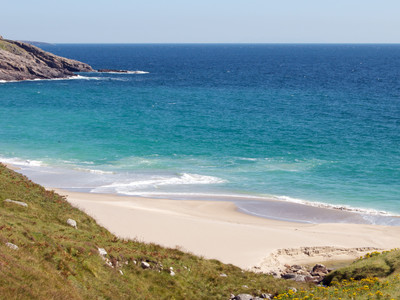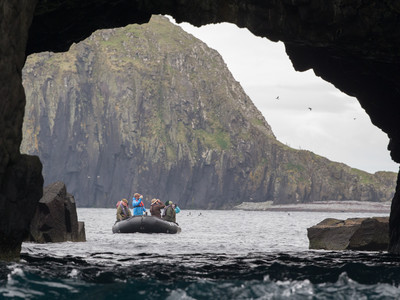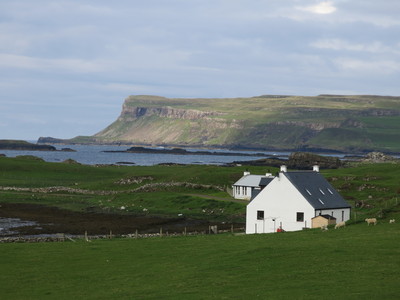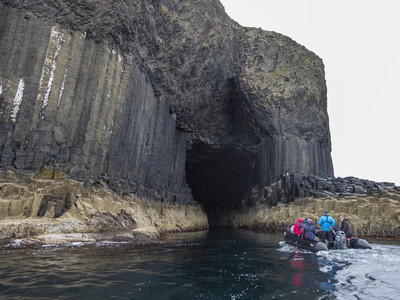Island Hopping in the Hebrides
9th to 16th May 2016
MS Hebridean Sky
Monday, 9th May 2016 – Embarkation in Oban
Gathering from all over the UK, we had travelled by bus from Glasgow, or by private transport to Oban. Winding between the stunning lochs and wilderness, we had our first introduction to the incredible landscapes which the country had to offer. Arriving in Oban, we were greeted by our expedition staff who helped us through security and to board the MS Hebridean Sky docked alongside. Once on board, we were introduced to our cabins and enjoyed a glass of champagne in the Lounge. After unpacking, we gathered in the lounge again at 5pm for our mandatory lifeboat drill and an introduction to the expedition team and to the ship. We headed out to anchor off Oban in the beautiful sunset where we lay for a few hours before setting out after midnight for our voyage to Mingulay in the Outer Hebrides. Before dinner Pam had briefed us with details of our first day’s activities. Everybody was in good spirits, sharing experiences and life stories over dinner. The long day of travel had many eyes drooping and most of us headed straight to bed, and a pleasant crossing of the Sea of the Hebrides.
Tuesday, 10th May 2016 - Mingulay and Pabbay

Not long after dawn Pabbay, Mingulay and Berneray appeared on the horizon with small groups of seabirds – guillemots, gannets and fulmar – commuting back and forth. As we dropped anchor we could see about a thousand grey seals hauled out on Mingulay’s sandy beach. Some kayakers were camped ashore and must have disturbed the seals when they came ashore the previous day. The seals are moulting at the moment and feel more comfortable ashore than in the sea. After breakfast a scout boat went ashore to confirm the conditions were good and a landing was perfectly possible. We experienced our first wet landing at the south end of the beach (so as not to disturb the seals) and we made ready for our choice of walks on Mingulay – the ‘Vikings’ led by Rick and Ian made for the skyline to view the majestic 700 foot cliffs. They saw some of the seabird colonies, a few nesting great skuas, and at least three eagles, one of which was one of the resident golden eagle pair, and the others immature sea eagles.
John led the ‘Highlanders’ round the Bay, telling us some of the history of the island. We heard a corncrake and some of us were lucky enough to spot it as it scuttled between the ruins of the houses. There were also some ringed plover, oystercatchers, wrens singing, and a stonechat as well as a couple of migrant swallows, pied wagtail and a redwing. Primroses and lesser celandine were in profusion with some violets, milkwort, butterbur and even a few early spring squill. When we reached the grassy slopes at the northern end where the puffins were nesting, there were already a couple of campers there so few puffins were in evidence ashore at their nesting burrows. But many hundreds were flying around in dense flocks (some quite close) with others sitting out on the sea. The kayakers disturbed the seals once more and a small boat came in with some snorkellers who tried to swim with the seals. The animals were curious and preferred to follow the swimmers and bite their fins! Our third group of passengers – the ‘Coasters’ – did not stray too far from the landing site, and soon we were all assembling for a return to the ship for lunch. We realised that, not only were we lucky to land on Mingulay at all, but we could not have enjoyed better weather for it!
After lunch on board the ship moved slightly north to anchor off the little island of Pabbay where, again, we were ferried ashore by the Zodiacs. While some did their own thing, Alan was on hand to direct the others towards John on the hillock which is the burial ground, and Ian at the ruined cottage. A corncrake called at the cottage while John explained the two carved stones – one incised cross from the 6 or 7th century and another rough cross below which was a Pictish symbol of a flower (this was however hard to make out because of the lichen growth. It proved a pleasant landing, enjoying the sunshine ashore and no particular strenuous walking. We all returned by 5pm in time to hear John give an informative lecture on St Kilda, our destination for tomorrow. There was then a recap and briefing where Alan, in his own inimitable style, showed slides of the flowers we had seen today, John showed a few slides of old Mingulay and its people and Rick introduced us to seals before Pam’s briefing about tomorrow.It had been a long and successful day so we were glad to retire to the cabins after dinner. We remained at anchor before setting out for St Kilda later in the evening.
Wednesday, 11th May 2016 – St Kilda
It proved a relatively calm voyage out into the Atlantic for our approach to St Kilda at dawn. The archipelago was clear of cloud, so once again we proved fortunate with the weather – especially with such remote islands yesterday and today. After breakfast Rick went ashore to fetch the National Trust for Scotland’s Area Manager for the Western Isles, Susan Bain who was accompanied by the new archaeology warden Jonathan Wordsworth. Susan explained the do’s and don’t’s for our landing. The light northeasterly proved little difficulty at the jetty. Chris led off the 9 valiant passengers who had opted for the Viking walk to the summit of Connachair, while Rick and Alan took the Highlanders only to the clifftop at the Gap. Good views were had by all, with some interesting birds and flowers. The ancient Soay sheep and stone ‘bee-hives’ or cleats (cleitean in Gaelic) added to the mystique and drama of the scene. John meanwhile took the remaining passengers from the gun along the Village Street. Everyone still had time to visit the museum and the shop before returning to the ship. It was wonderful to have lunch on the Lido Deck in the sunshine with such a wonderful backdrop. But there was more to come. The expedition team took most of the passengers out for a Zodiac ride in Village Bay and through the caves and tunnels at the back of Dun – a spectacular ride. All back aboard, the ship weighed anchor and proceeded round the back of Sun, up the east side of Hirta with Boreray and the Stacs reappearing as we rounded Soay.
John gave a helpful deck commentary pointing out the main features, and telling tales of times past. We viewed the highest sheer cliff in below the Connachair summit and on reaching Lee, the captain manouevered the ship through the narrow gap. Above us towered 9000 pairs of nesting gannets. To our left the bulk of the colony (some 60,000 breeding pairs – the second largest North Atlantic colony in the world, recently having been overtaken by the 75,000 pairs on the Bass Rock in the Firth of Forth). As we then approached Stac an Armin with the remaining 9 or 10 thousand pairs, Pam slowed the ship for us all to assemble on Deck 6 outside where a group photograph was taken, with the impressive backdrop of Stac an Armin. We then completed the circumnavigation of the St Kilda archipelago before heading north for the Butt of Lewis, via the Flannan Isles. At the recap and briefing Chris read W W Gibson’s poem about the disappearance of the Flannan Isles lightkeepers in December 1900 as John showed some slides of the place and then explained the most likely explanation, Alan talked about the current gannet (guga) hunt which takes place on Sulaisgeir (far to the northeast of St Kilda), Ian discussed the St Kildans and then Pam gave us a briefing about tomorrow. After dinner and as it got dark we passed the Flannan Isles.
Thursday, 12th May 2016 - Handa and Tanera Mor

After a comfortable passage the ship anchored in the lee of the island of Handa where we had breakfast before disembarking for an hour and a half’s Zodiac cruise of the seabird cliffs. The Torridonian sandstone ledges provided ideal nest sites for thousands of guillemots, razorbills and kittiwakes which thronged above the Zodiac in a cacophony of sound and smell. There were some shags and of course plenty fulmar but only a few puffins and, curiously, no black guillemots. Piratical great skuas patrolled the skies for unlucky kittiwakes returning with fish in the beaks. We also saw some grey seals. All too soon both shifts of passengers had been taken for their respective Zodiac rides while John delivered an excellent short lecture on seabirds for those waiting on board for their turn. At about 1130 the ship continued south along the amazing mountain landscape of Wester Ross to anchor off Tanera Mor in the Summer Isles, just off Ullapool. Again with a pleasant wind on our stern, if we wished, we could dine outside on the Lido Deck to fully appreciate the scenery. We passed the Old Man of Stoer (a small rock pinnacle not to be confused with the Old Man of Storr in Skye), and Stoer lighthouse just to the south. The Isle of Lewis was misty on the western horizon.
Rick went in to fetch Richard Williams, the son-in-law of the owner, and his manager Tim, who delivered a very informative introduction to the island and its history. It proved a rather long, and splashy, transfer ashore for us, where most took off in a long line up to the viewpoint on the hill behind the bay to take in the spectacular panorama of the mainland, the Summer Isles themselves and even the Isles of Lewis and Harris to the west. Someone heard the first cuckoo of our spring and several other bird species and some interesting flowers were added to the list. The Post Office and Tea Shop provided a welcome stop, where the interesting selection of unique Summer Isles postage stamps could be purchased. They covered the postage from the island to the mainland only so a normal postage stamp was still necessary. We filtered slowly back to the ship ready to change for the official and combined Captain’s Welcome and Farewell where an excellent meal and good conversation was enjoyed by all: ‘all’ meaning those who could withstand the motion of the ship as it crossed the swell to Stornoway 38 miles away. It was a short crossing however and soon we were in the lee of the harbour where we docked for the night. With guidance from two local ‘ambassadors’ some ventured ashore to explore the town, but many preferred to turn in for the night.
Friday, 13th May 2016 - Stornoway and Shiant Isles
After a sound and motionless sleep we emerged outside to a cloudy sky and a chilly northerly breeze. Most opted to breakfast in the Dining Room and by 0830 all were ready to embark the three coaches waiting on the quayside.
The morning was spent on a tour of central Lewis out of Stornoway. We visited the famous Standing Stones of Callanish, an impressive assemblage of monoliths arranged (quite fortuitously and 5000 years older than) in the shape of a Celtic cross with an avenue leading to the huge central standing stone, beside a much later Bronze Age burial cairn. The stones are all of the local Lewisian gneiss, metamorphic (remelted) and banded grey, and some of the oldest rocks in the world (3 billion years old). The assorted shapes and sizes suggesting an alternation between finger-like stones and diamond-shaped ones (male and female??). During the cooler/wetter Bronze Age they fell into disuse and became half-buried in peat. Other than digging out the peat for domestic use the fiercely Protestant islanders have left them, largely unharmed and standing proud in a small fenced enclosure within the croftland. As many as a dozen other minor stone circles can be seen in the vicinity so the site was obviously of hugely significant importance – the ‘Stonehenge of the North’ and indeed are mentioned by early Greek chroniclers. There was a beautifully designed visitor centre/craft shop/ tea room cleverly situated so as not to intrude on the stones themselves, yet constructed of drystone walling to blend in with the overall theme.
Dun Carloway is a finely constructed Iron Age broch, shaped like an upturned egg-cup, with double-walls and a staircase between, probably several floors, and a single low door. It has been robbed of stone on one side only and near what was probably a roof, to reveal this clever internal structure. It may have served as a beacon to alert other tribes in the area of danger, and would have served as a defensive place of refuge; but also it seems to have made a statement about the strength and social status of the builders. This type of structure occurs throughout the north and west of Scotland and all are remarkably uniform in construction: some postulate all built by a successive generations of the same, specialised, family or tribe. Our third stop was a delightful village called Garenin, a cluster of reconstructed thatched cottages or blackhouses which today house a gift shop/tearoom, a hostel, meeting facility, and a demonstration homestead where there is usually a demonstration of Harris Tweed weaving. All too soon we had to depart and continue our tour back to Stornoway, past the whalebone arch at Bragar, the wartime memorial etc. Lunch was aboard the ship.
Despite a 20 knot wind our intention to Zodiac cruise around the Shiants was still on the cards, though we delayed our departure by a few hours to let the weather improve. But when we entered the Minch the winds appeared much stronger and so instead the ship circumnavigated the islands, which consisted of Eilean Mhuire (Mary’s Isle) to the north, Eilean Tighe (House Island) and the spectacular Garbh Eilean (Rough Island) to the south, the two joined by a boulder beach. The islands are owned by Adam Nicholson who wrote about them so eloquently in his book ‘Sea Room’ and are uninhabited. In ideal light conditions we were viewing Tertiary basalt columns several hundred feet tall and thronging with seabirds, many of whom wheeled around as we cruised close off shore. John gave a commentary from the bridge and everyone had good views of puffins, both on the sea and flying around, along with guillemots and razorbills, some shags, kittiwakes etc. Several passengers caught glimpses of a sea eagle high against the sky but only momentarily. The highest cliff housed one of the very last breeding pairs early in the 20th century but a highly successful reintroduction programme (begun on the Isle of Rum in 1975) has resulted in some 100 pairs now established in Britain (mainly the Hebrides) once again. At 5pm Chris gave a fascinating talk on the geology of the Hebrides, which was followed at 7pm by a Recap and Briefing. Alan gave an entertaining and informative short talk on the Lewis Chess Men, Ian gave a short chat on blackhouses while Chris discussed drystone walling before Pam ended with an outline of our plans for tomorrow. The ship continued her passage south during dinner, with the wind on our tail, and sought shelter for the night at anchor off Glen Brittle on the west coast of Skye.
Saturday, 14th May 2016 – Canna and Muck

After a peaceful night Hebridean Sky heaved up her anchor around 7 am and crossed to the Isle of Canna during breakfast. The winds had dropped considerably and we anchored close to the pier so that it was a short Zodiac ride ashore. Three National Trust for Scotland guides – Stuart, Gordon and David – were waiting to lead us on a short but attractive walk, while John took the last and smallest group. Skirting the shore we saw oystercatchers, a common sandpiper etc and heard a cuckoo. Corncrakes had recently arrived and several passengers saw three eagles on the skyline which, from their description, John surmised were two white-tailed sea eagles being mobbed by a young golden eagle. Our route turned up through farm fields, past the lovely little woodland where the previous owner John Lorne Campbell is buried (his wife, the American Margaret Fay Shaw is buried in South Uist beside the two old ladies she lived with, collecting Gaelic folk songs. John Lorne was also collecting songs and folklore in Barra at the same time and after they married John bought the Isle of Canna in 1938. He gifted the island to NTS in 1981 together with his extensive Gaelic library, recordings of songs and stories (now digitised) and Margaret’s collection of photographs of the Uist and Barra islanders and their way of life.
From the high house Tigh Ard, the views across to Rum (4 miles to the east), Mull and the mainland were astonishingly beautiful and clear in the sunshine. A small path led down through the trees, carpeted with bluebells and wild garlic to Canna House. It was not possible to view inside as there were too many of us, and the National Trust Patrons had arrived on an official visit. But we had time to snatch a coffee in the Community Shop and buy a few souvenirs before heading back to the pier for the last Zodiac at 1130, The ship weighed anchor and made her way round the southwest end of Rum during lunch to anchor off the Isle of Muck. John and Chris had given a commentary from the bridge explaining the geology and history of the island, the largest of the four Small Isles. We landed on the smallest, the Isle of Muck, for the afternoon, and enjoyed a short walk across Gallanach beach on the other side (hearing cuckoos again) and also the culinary delights and crafts of the local shop run by the owner’s wife Jenny. Lawrence MacEwen himself came to chat amongst us. His family had owned the island since 1896 and had managed to maintain a thriving community around the farm, holiday lets, tourism and the new fish farm. John considered the MacEwens the finest landowners in Scotland. All too soon it was time to leave and as the ship continued on her course south John gave a short commentary from the bridge pointing out Ardnamurchan Point (the westernmost point of the Scottish mainland., with its lighthouse, the islands of Treshnish and Iona (tomorrow’s destination), Mull, Coll and Tiree. We saw a few large flocks of Manx shearwaters and some thought they saw dolphins and a whale blow. At 7pm John showed some slides of a sheep gather on the Shiant Isles, Ian chatted about Scots words and phrases and Stuart explained about the Beaufort Scale before Pam again outlined tomorrow’s plans. At dinner Hebridean Sky came to anchor at the head of Loch Scridein in Mull, surrounded by the island’s sunlit hills and later Chantal gave a vivid talk on the transformation of the ship from its previous life as the Sea Explorer. Despite minor glitches this cruise it was astonishing to see how much work the contractors and crew had done to make her the comfortable new vessel she is now. Another calm night at anchor.
Sunday, 15th May 2016 - Iona, Staffa and Lunga

We steamed out of the shelter of Loch Scrieden below Ben Mor during breakfast and were soon at our anchorage just to the northeast of Iona. It was a cold, fifteen minute run in the Zodiacs to the pier but we had plenty time to wander idly along to the Abbey, via the pleasant gardens of the old Nunnery. Some of us heard corncrakes, others had excellent views out in the open and even flying; always a good chance at this time of year with the vegetation so low and open. The Historic Scotland guides were scattered through the buildings ready to answer questions and a church service was held at 1030. Some of us opted to join Alan and Ian led a nature walk, seeing oystercatchers, singing sedge warblers etc. Yesterday with their woodland, Canna and Muck added lots of new species to our species list, but today in the tall trees we were able to add rook and jackdaw for instance. We had all passed an enjoyable morning ashore but to add to the excitement, three or four of the Zodiacs returning to the ship had wonderful views (and photographs) of bottlenosed dolphins bow-riding; they had split off from the car ferry to enjoy the speed of our boats!
Back aboard we had a hasty lunch so that we could enjoy views of Fingal’s Cave on Staffa as the ship eased close inshore. We turned north to proceed out to Lunga, the largest of the Treshnish Isles. Riding ashore in the Zodiacs we saw plenty of puffins, guillemots, razorbills with some shags, kittiwakes and fulmars but nothing quite prepared us for the spectacle ashore. Fortunately most people opted to land on Lunga and persisted over the rock and up the short but steep path to be well rewarded with the closest views of puffins anywhere in the country. John had landed here dozens of times over the last seven years and had never seen so many. A few fearless rabbits grazed amongst them while fulmars and a few shags also nested on the cliffs. Those that decided to continue along the cliff path to Harp Rock added nesting razorbills, shags, more fulmars to the list as well as singing wrens and rock pipits. But it was the throng on nesting guillemots on the broad rock ledges of Harp Rock itself that provided the reward for that extra journey. The photo opportunities were endless. It was the cold wind rather than the lack of excitement that eventually brought us back to the ship, so that by 6 pm Hebridean Sky was able to up anchor head north and enter the Sound of Mull to anchor off Oban later this evening. After the amazing start to the voyage on Mingulay/Pabbay and St Kilda the good weather continued most days with only the failure to achieve the Zodiac cruise around the Shiants being the only real hitch and now Lunga provided more than a fitting end to the whole cruise. Sadly we all had to pack, and to present ourselves for a farewell dinner before Chris and the team presented a slide show of the voyage in the Lounge before we all finally retired.
Monday, 16th May 2016 – Disembarkation in Oban
All too soon our memorable voyage was at an end and we had to disembark in Oban first thing for our various routes home.
End of Voyage
For further inspiration, view slideshow of images taken during the voyage
View all Hebrides Cruises





